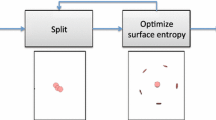Abstract
The correspondence problem is of high relevance in the construction and use of statistical models. Statistical models are used for a variety of medical application, e.g. segmentation, registration and shape analysis. In this paper, we present comparative studies in three anatomical structures of four different correspondence establishing methods. The goal in all of the presented studies is a model-based application. We have analyzed both the direct correspondence via manually selected landmarks as well as the properties of the model implied by the correspondences, in regard to compactness, generalization and specificity. The studied methods include a manually initialized subdivision surface (MSS) method and three automatic methods that optimize the object parameterization: SPHARM, MDL and the covariance determinant (DetCov) method. In all studies, DetCov and MDL showed very similar results. The model properties of DetCov and MDL were better than SPHARM and MSS. The results suggest that for modeling purposes the best of the studied correspondence method are MDL and DetCov.
We are thankful to C. Brechbühler for the SPHARM software and to G. Gerig for support and insightful discussions. D. Jones and D. Weinberger at NIMH (Bethesda, MD) provided the MRI ventricle data. J. Lieberman and the neuro-image analysis lab at UNC Chapel Hill provided the ventricle segmentations. This research was partially funded by the Swiss National Centers of Competence in Research CO-ME (Computer assisted and image guided medical interventions). The femoral head datasets were provided within CO-ME by F. Langlotz.
Access this chapter
Tax calculation will be finalised at checkout
Purchases are for personal use only
Preview
Unable to display preview. Download preview PDF.
Similar content being viewed by others
References
Bookstein, F.L.: Morphometric Tools for Landmark Data: Geometry and Biology. Cambridge University Press, Cambridge (1991)
Brechbühler, C., Gerig, G., Kübler, O.: Parameterization of Closed Surfaces for 3-D Shape Description. Comp. Vision and Image Under. 61, 154–170 (1995)
Brett, A.D., Taylor, C.J.: Construction of 3D Shape Models of Femoral Articular Cartilage Using Harmonic Maps. In: Delp, S.L., DiGoia, A.M., Jaramaz, B. (eds.) MICCAI 2000. LNCS, vol. 1935, pp. 1205–1214. Springer, Heidelberg (2000)
Christensen, G., Joshi, S., Miller, M.: Volumetric Transformation of Brain Anatomy. IEEE Trans. Med. Imag. 16(6), 864–877 (1997)
Cootes, T., Hill, A., Taylor, C.J., Haslam, J.: The Use of Active Shape Models for Locating Structures in Medical Images. Img. Vis. Comp. 12, 355–366 (1994)
Davies, R.H., Twining, C.J., Cootes, T.F., Waterton, J.C., Taylor, C.J.: 3D Statistical Shape Models Using Direct Optimization of Description Length. In: Heyden, A., Sparr, G., Nielsen, M., Johansen, P. (eds.) ECCV 2002. LNCS, vol. 2352, pp. 3–20. Springer, Heidelberg (2002)
Davies, R.H: Learning Shape: Optimal Models for Analysing Natural Variability. Dissertation University of Manchester (2002)
Davies, R.H, Twining, C.J., Cootes, T.F., Waterton, J. C., Taylor, C.J.: A Minimum Description Length Approach to Statistical Shape Model. IEEE TMI 21 (2002)
Fleute, M., Lavallee, S.: Building a Complete Surface Model from Sparse Data Using Statistical Shape Models. In: Wells, W.M., Colchester, A.C.F., Delp, S.L. (eds.) MICCAI 1998. LNCS, vol. 1496, pp. 879–887. Springer, Heidelberg (1998)
Gerig, G., Styner, M.: Shape versus Size: Improved Understanding of the Morphology of Brain Structures. In: Niessen, W.J., Viergever, M.A. (eds.) MICCAI 2001. LNCS, vol. 2208, pp. 24–32. Springer, Heidelberg (2001)
Hill, A., Thornham, A., Taylor, C.J.: Model-Based Interpretation of 3D Medical Images. In: Brit. Mach. Vision Conf. BMCV, pp. 339–348 (1993)
Hug, J., Brechbühler, C., Székely, G.: Tamed Snake: A Particle System for Robust Semi-automatic Segmentation. In: Taylor, C., Colchester, A. (eds.) MICCAI 1999. LNCS, vol. 1679, pp. 106–115. Springer, Heidelberg (1999)
Joshi, S.C., Banerjee, A., Christensen, G.E., Csernansky, C., Haller, J.W., Miller, I., Wang, L.: Gaussian Random Fields on Sub-Manifolds for Characterizing Brain Surfaces. In: Duncan, J.S., Gindi, G. (eds.) IPMI 1997. LNCS, vol. 1230, pp. 381–386. Springer, Heidelberg (1997)
McInerney, T., Terzopoulos, D.: Deformable Models in Medical Image Analysis: A Survey. Med. Image Analysis 1(2), 91–108 (1996)
Kelemen, A., Székely, G., Gerig, G.: Elastic Model-Based Segmentation of 3D Neuroradiological Data Sets. IEEE Trans. Med. Imag. 18, 828–839 (1999)
Kotcheff, A.C.W., Taylor, C.J.: Automatic Construction of Eigenshape Models by Direct Optimization. Med. Image Analysis 2(4), 303–314 (1998)
Van Leemput, K., Maes, F., Vandermeulen, D., Suetens, P.: Automated Modelbased Tissue Classication of MR Images of the Brain. IEEE TMI 18, 897–908 (1999)
Meier, D., Fisher, E.: Parameter Space Warping: Shape-Based Correspondence Between Morphologically Different Objects. Trans. Med. Imag. 12, 31–47 (2002)
Rangarajan, A., Chui, H., Bookstein, F.L.: The Softassign Procrustes Matching Algorithm. In: Duncan, J.S., Gindi, G. (eds.) IPMI 1997. LNCS, vol. 1230, pp. 29–42. Springer, Heidelberg (1997)
Rueckert, D., Frangi, A.F., Schnabel, J.A.: Automatic Construction of 3D Statistical Deformation Models Using Non-rigid Registration. In: Niessen, W.J., Viergever, M.A. (eds.) MICCAI 2001. LNCS, vol. 2208, pp. 77–84. Springer, Heidelberg (2001)
Styner, M., Gerig, G., Lieberman, J., Jones, D., Weinberger, D.: Statistical Shape Analysis of Neuroanatomical Structures Based on Medial Models. Med. Image Anal.
Szeliski, R., Lavallee, S.: Matching 3-D anatomical surfaces with non rigid deformations using octree-splines, Int. J. Computer Vision 18(2), 200–290 (1996)
Tagare, H.: Shape-Based Nonrigid Correspondence with Application to Heart Motion Analysis. IEEE Trans. Med. Imag. 18(7), 570–580 (1999)
Wang, Y., Peterson, B.S., Staib, L.H.: Shape-based 3D Surface Correspondence Using Geodesics and Local Geometry. CVPR 2, 644–651 (2000)
Author information
Authors and Affiliations
Editor information
Editors and Affiliations
Rights and permissions
Copyright information
© 2003 Springer-Verlag Berlin Heidelberg
About this paper
Cite this paper
Styner, M.A. et al. (2003). Evaluation of 3D Correspondence Methods for Model Building. In: Taylor, C., Noble, J.A. (eds) Information Processing in Medical Imaging. IPMI 2003. Lecture Notes in Computer Science, vol 2732. Springer, Berlin, Heidelberg. https://doi.org/10.1007/978-3-540-45087-0_6
Download citation
DOI: https://doi.org/10.1007/978-3-540-45087-0_6
Publisher Name: Springer, Berlin, Heidelberg
Print ISBN: 978-3-540-40560-3
Online ISBN: 978-3-540-45087-0
eBook Packages: Springer Book Archive




